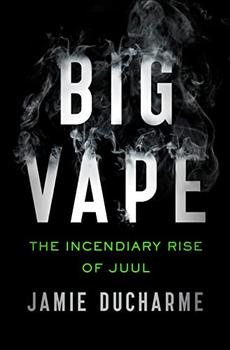Summary | Excerpt | Reviews | Beyond the Book | Readalikes | Genres & Themes | Author Bio

The Incendiary Rise of Juul
by Jamie Ducharme
Standing in a darkened lecture hall in June 2005 with a PowerPoint presentation displayed behind them, James stepped forward to sell his classmates on this idea. "Adam and I were interested in working on designing for social change," James said. "We acknowledged right away that smoking was probably an easy target. There's a lot of people that smoke who are really at odds with themselves. They really enjoy the process of smoking, but at the same time, every cigarette is really self-destructive." Throughout the eighteen-minute thesis presentation, James and Adam laid out their vision for a portable vape pen that would use a liquid fuel source to heat tiny pods of flavored tobacco, producing a nicotine-laced aerosol that users could inhale without harming their health or smelling like smoke. Its design was inspired by a mash-up of the Nespresso coffee pods that were at that time sweeping Europe and the hookahs that were sweeping college campuses. Like a hookah, which uses hot coals to heat tobacco, Ploom would heat tobacco pods without burning them.
"It turns out actually that burning tobacco is the real problem. Nicotine is addictive, clearly, but it's not the nicotine that's really hurting you; it's mostly the combustion that's a problem," James said during the presentation. To support this idea, he pointed to the tobacco industry's search for a safe cigarette, from Ariel all the way up to Accord. (As two product design students, he and Adam didn't have the time, resources, or expertise to conduct clinical research themselves, so they were largely assuming that Ploom would indeed be safer than a cigarette simply by virtue of its being a noncombustible product, though they said they planned to conduct additional research later.) But, James concluded, "there's no design innovation going on in smoking whatsoever, because Big Tobacco's really interested in not shooting themselves in their own foot"—in other words, traditional tobacco companies didn't want to create something that would cannibalize cigarette sales. James and Adams were more than happy to fill that void.
Colter Leys remembers watching the presentation and realizing that Adam and James weren't going to stop until they got it done. "For other people, [thesis season] was a finale. For them, it was a milestone in the middle of a process," he says. "For better or for worse, they were already on their way."
It would have been easy, watching Adam and James's presentation, to think they were designing a smoking-cessation product. But their actual message was subtler than that. Toward the middle of the presentation, James asked the big question, the one that would inform Ploom's ethos as it came into existence: "What if smoking were safe?" he asked. "And, even better, what if smoking were actually not offensive to others?" Health was clearly important to the two men—never mind the fact that they hadn't actually studied Ploom to see if it was safer than a cigarette—but to them, "even better" than health was a future in which smoking didn't have to be a dangerous, dirty little secret. If smoking were safer, cleaner, and less annoying for bystanders, it could become cool again. The entire presentation was laced with callbacks to Adam's earlier realization that most smokers don't actually want to quit; they just don't want to die. "Our goal," Adam told his classmates, "was to basically create a whole new experience for people that retains the positive aspects of smoking, the ritual and everything, but that makes it as healthy and socially acceptable as possible."
Everything came down to that sentence. If you listened carefully, you heard that Ploom wasn't meant to be a smoking-cessation product. It was meant to be the rebirth of the cigarette.
Excerpted from Big Vape by Jamie Ducharme. Copyright © 2021 by Jamie Ducharme. Excerpted by permission of Henry Holt and Company. All rights reserved. No part of this excerpt may be reproduced or reprinted without permission in writing from the publisher.
Your guide toexceptional books
BookBrowse seeks out and recommends the best in contemporary fiction and nonfiction—books that not only engage and entertain but also deepen our understanding of ourselves and the world around us.